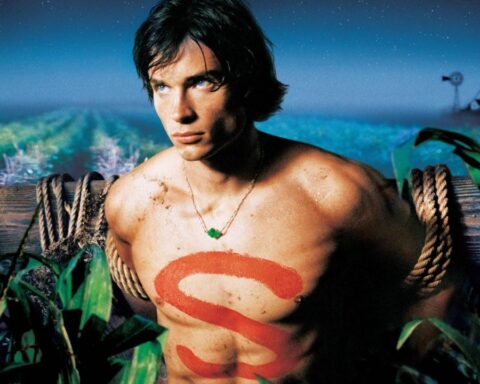As we eagerly await Denis Villeneuve’s take on Frank Herbert’s Dune, we’ve put together a series of articles on how the franchise has been adapted, depicted, and received in the 55 years since it was first published.
In this instalment, Iain McNally revisits the Sci-Fi Channel’s ambitious mini-series from the year 2000.
20 years ago, a young man emerged from a desert planet and changed the fate of the galaxy forever. No, his name wasn’t Anakin, or even Luke, Skywalker and he didn’t come from a galaxy far, far away. His name was Paul Atreides, aka Muad’Dib, he lived almost 20,000 years in the future, and he last appeared on our screens in the Sci-Fi Channel’s adaptation of Frank Herbert’s Dune in 2000, as well as its sequel series Children of Dune, three years later.
Arrakis, the Planet Known as Dune
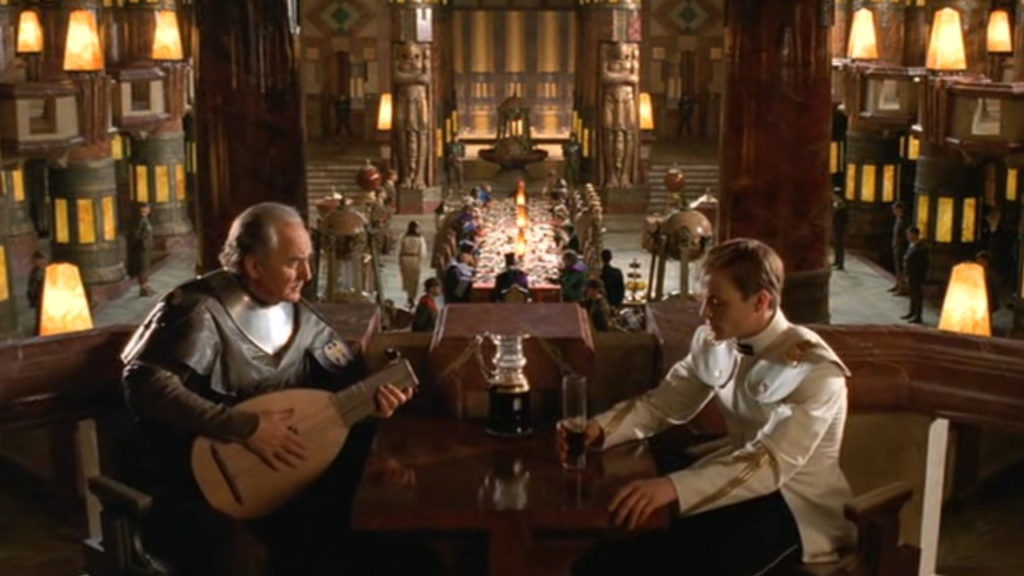
While David Lynch’s take on the Herbert’s sci-fi classic in 1984 provided some… arresting visuals, the story of galactic politics, mind and reality warping space, and the young Paul Atreides’ escape from his family’s enemies, only to return at the head of an army of fanatical warriors, ended up so truncated, that the majority of the book’s impact was lost. With this adaptation, the filmmakers, which included director/writer/composer/actor John Harrison, cinematographer Vittorio Storaro (Apocalypse Now, Dick Tracy, Ladyhawke, The Last Emperor) and the Hallmark channel (!) set out to remedy that.
They started by giving the book the one thing Lynch couldn’t: time.
They Have Been the Sand in Our Eyes!
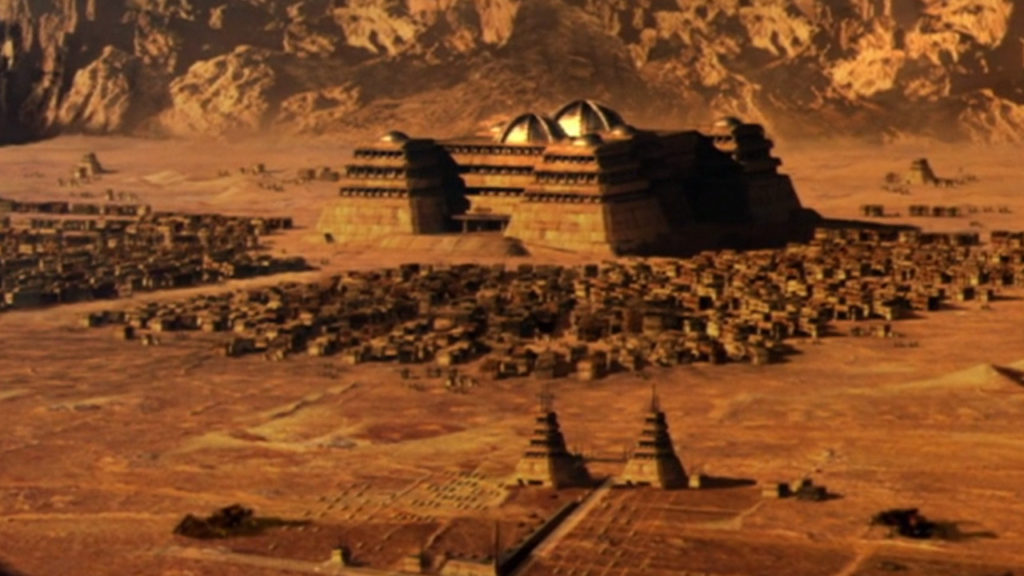
Spread out over three episodes, and clocking in at almost four and a half hours, the miniseries gives Dune far more room to breathe than the two hours and 17 minutes of the final release of Lynch’s film. Watching the miniseries now, however, the very first thing that jumps out at you, unfortunately, is the late 90’s/early aughts CGI special effects.
While the physical sets are lavish and imposing, with impressively high ceilings, when it comes to exterior shots, the CGI has not aged well.
It might have been the pinnacle of technology at the time, but unlike the dinosaurs in the first Jurassic Park, the shiny “CGI-ness,” and simplicity of the models, is all too clear under the harsh glare of Dune’s desert sun.
Bless the Maker and His Water.
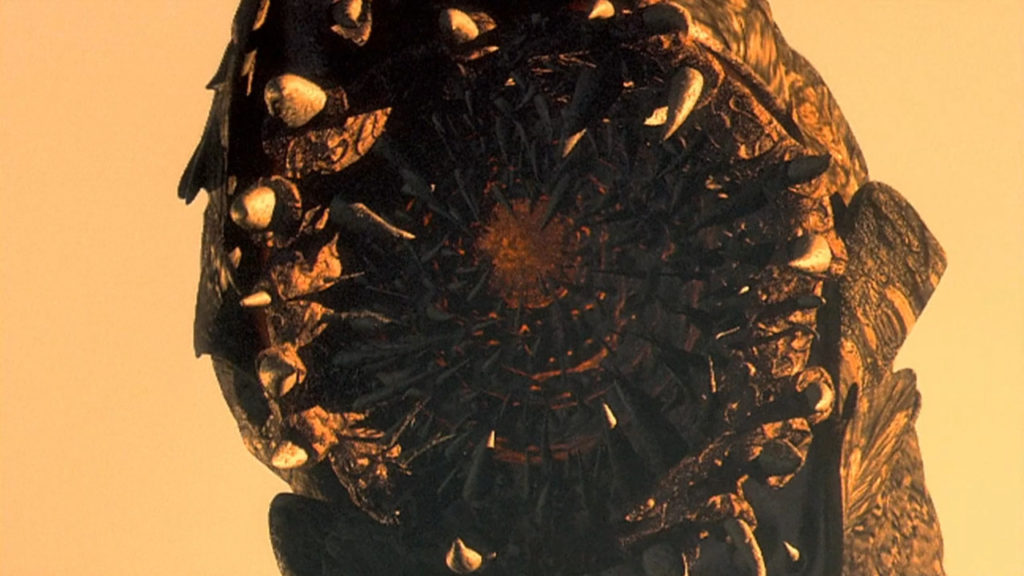
The one element that manages to avoid this, surprisingly, are the great makers themselves, Shai-Hulud or the Sandworms. With a far more armored appearance than Lynch’s versions, as well as far bigger “teeth,” they are an imposing presence.
When it comes to the worms’ human co-stars however, the results are a little more hit and miss.
Shot in Prague in the Czech Republic, the series features a truly international cast and the variety of accents does give it a somewhat otherworldly feel. It can lead to some odd situations, however, where the Fremen, native after a fashion, to the planet of Dune, have a variety of accents, from Czech (Chani and Liet Kynes), to German (Stilgar), to English (Otheym, although he is played, I believe by a Czech actor).
Obviously the biggest draw is William Hurt, the most well known star in the cast at the time. He provides the required gravitas as Paul’s father, the doomed Duke Leto Atriedes, and thanks to that longer running time, gets far more screen time than Jürgen Prochnow ever did in Lynch’s version.
Alec Newman plays Paul Atreides, aged up in much the same way as the Stark children were for the Game of Thrones. Despite the rest of the accents on show, there’s zero trace of Newman’s Scottish accent (which I only discovered from this production video while researching this article).
The Hero’s Journey
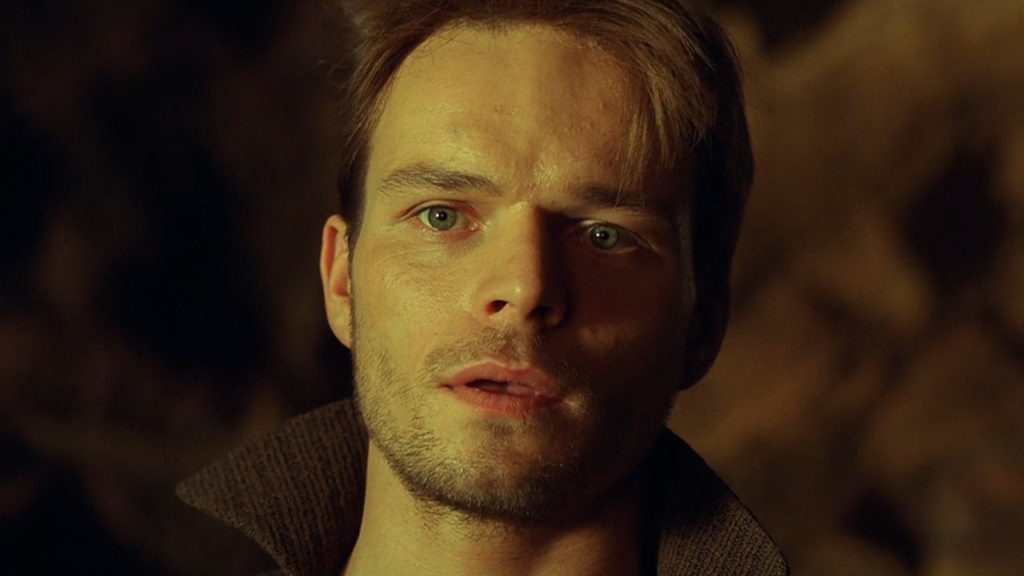
As with the Skywalker boys, it’s almost impossible to like Paul at the start of the story. Entitled and spoilt, he whines about going on the adventure of a lifetime. Once he’s fled from the Harkonnen into the desert, with his mother Jessica, and gets a nice new buzzcut, he becomes a far more likable hero.
In contrast to Lynch’s Dune, this Paul doesn’t provide any narration of events, including his spice induced visions of the future. The realization of these visions highlight the slightly unbalanced nature of the production. Some just look plain goofy – such as a model of Paul’s face in the sand – while others can provide some of the most arresting imagery of the series. While fans of the books will know exactly what these visions mean, its a bold choice not to spell everything out for fresh viewers.
That Which Submits… Rules
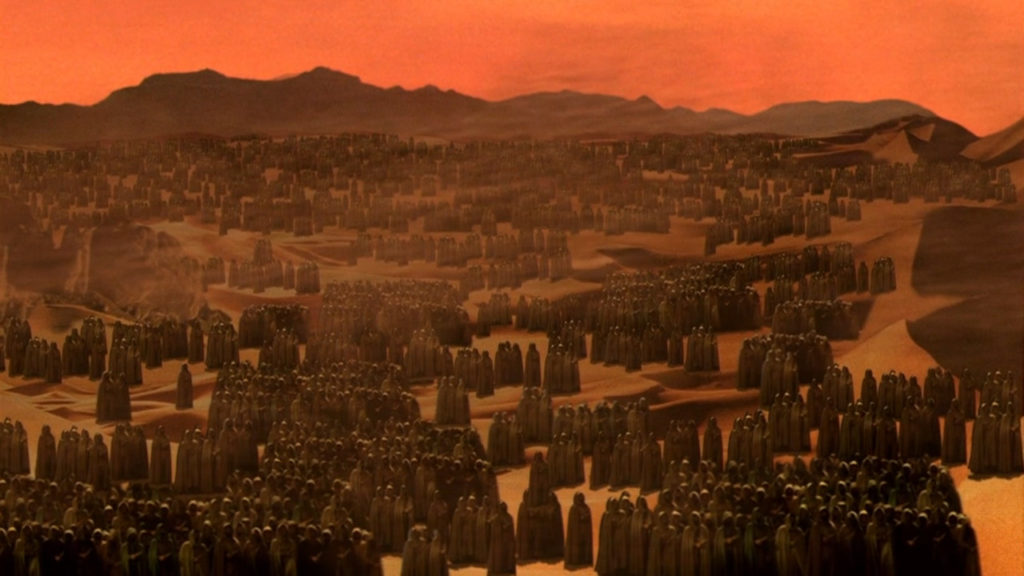
As Paul’s mother, the “Bene Gesserit witch” Jessica, Saskia Reeves doesn’t quite manage to pull off the combination of vulnerability and hidden danger of the future reverend mother.
It’s a balance that tends to affect some of the other characters too, at least initially. Ian McNeice, who usually plays more cuddly English characters and is probably more familiar as Winston Churchill during Matt Smith’s tenure as Doctor Who, doesn’t quite seem to be know what he’s trying to achieve with the Baron Harkonnen as the series begins. It’s only as events unfold that he really embraces the more theatrical, lascivious aspects of the Baron, as well as some choice undergarments, and comes into his own. So much so that it’s a delight to see a version of him return in the sequel series.
Tell Me, Boy, Why I Shouldn’t Kill You Right Here?
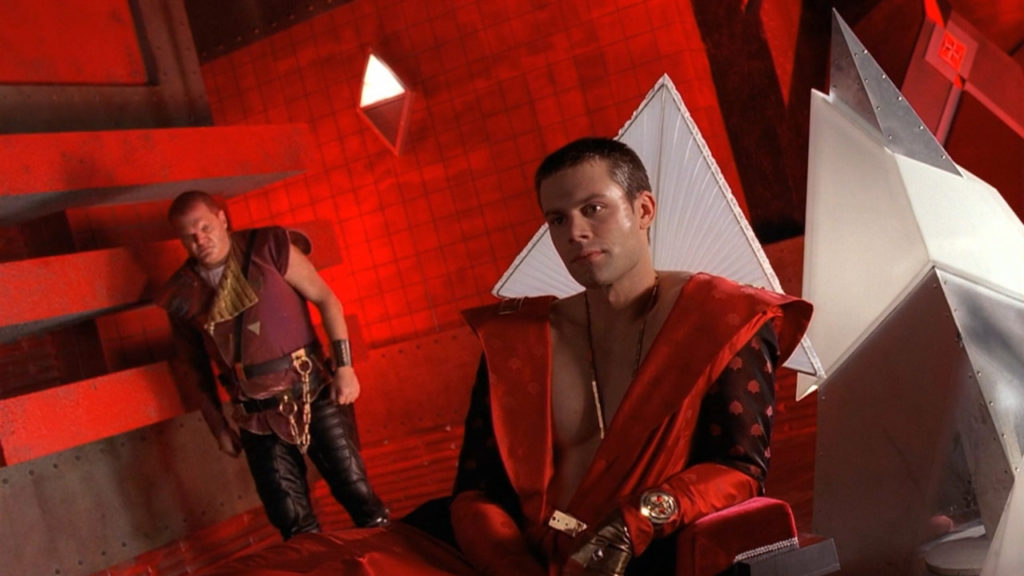
When it comes to the Harkonnen heir apparent, Feyd Rautha, it’s hard to match the sheer lunatic charisma of the musician Sting in a pair of leather undies from Lynch’s film, but future Middleman, Matt Keeslar, gives a game performance considering the ridiculous get-ups he’s expected to wear. One delightful outfit sports a giant, white, floppy triangle glued to the back for no apprent reason.
German actor Uwe Ochsenknecht comes across as suitably harsh, yet caring, as Stilgar, leader of the Fremen who take in the fugitive Jessica and Paul. Ochsenknecht is one of the actors recast for Children of Dune, replaced with Steven Berkoff, and you really do miss his presence.
Aside from a larger role for Princess Irulan (Julie Cox), the miniseries follows the books quite closely. There are times when the first episode almost feels like a space set Game of Thrones. The scope then changes in Episode 2 as Paul and Jessica hide themselves amongst the Fremen. Exploiting the Fremen’s messianic belief system in ore to survive until, thanks to Paul’s genetic heritage and Spice infused visions of the future, he starts to fulfill that role for real.
Fear Is the Mind Killer
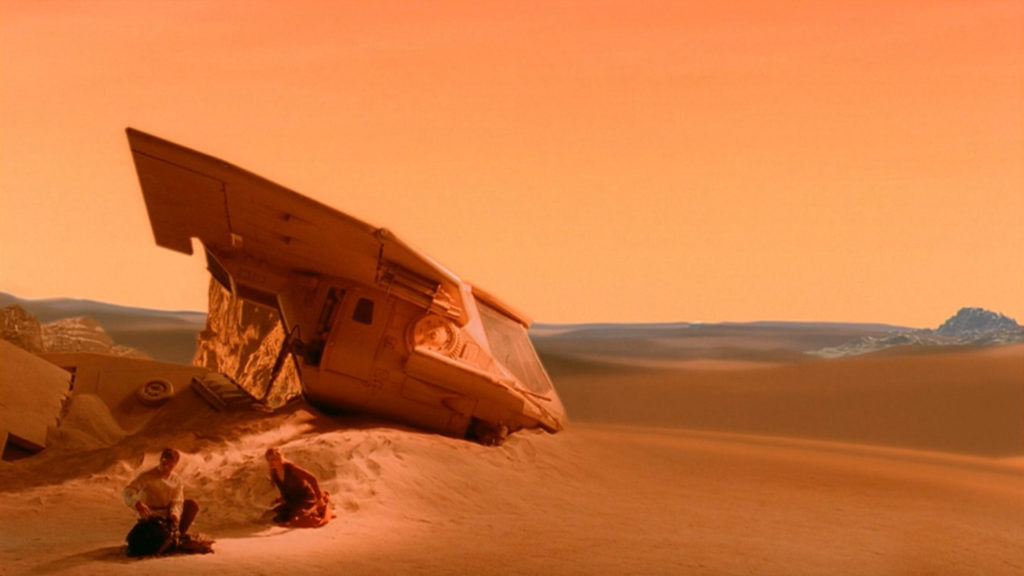
As the series spends more and more time in the desert of Arrakis, the filmmakers decision not to shoot on location starts to bear unreliable fruit. Shooting on a massive, sand filled sound stage, with giant computer enhanced photographs as backgrounds, can at times create absolutely staggering vistas. At others, it can look pretty obvious the actors are standing on a pile of sand in front of a tarp.
It’s a good example for the overall quality of the series. For every element it nails there are others that just miss their target. The romance between Paul and Chani (played by Czech actress Barbora Kodetová) never really takes off. This might be due to a language barrier, the makeup artists overdoing it with the hair crimper on Chani, or just due to the miniseries being a little too faithful to the book. At times the miniseries can feel a quite “stagey”, as the actors try to deliver portentious lines, without leaving space for the scenes to come to life.
This becomes far more noticeable watching in the sequel mini series Children of Dune, which is based upon both the Dune Messiah and Children of Dune books. In the follow up, which also stars Susan Sarandon as one of the antagonists, characters seem to spend more time actually interacting, rather than trying to live up to the idea of making a sci-fi classic. A quiet scene between Muad’Dib and Chani in the first episode of Children of Dune holds more emotional tension than nearly all their scenes put together in Dune.
Blue Eyes, Baby’s Got Blue Eyes
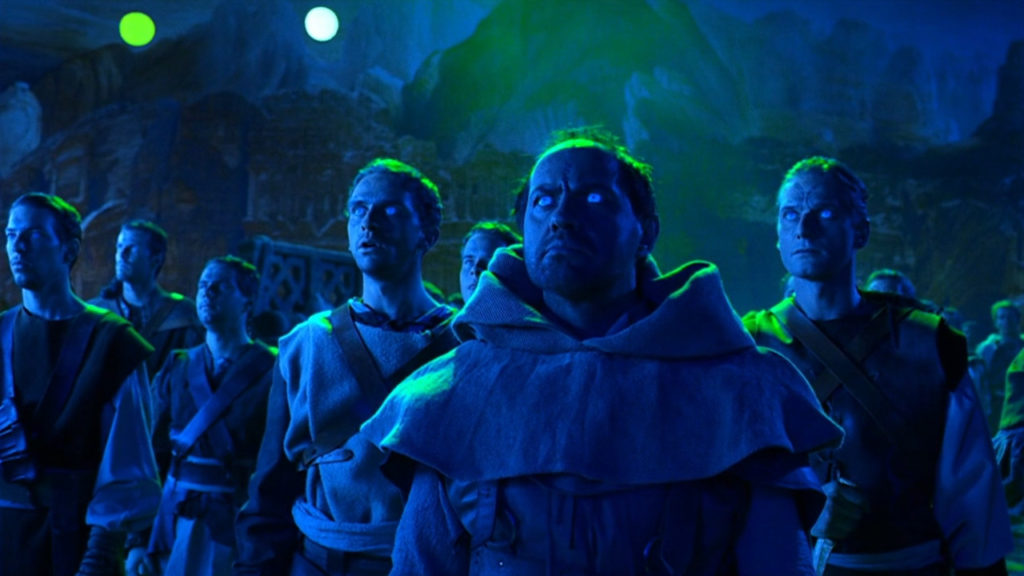
When it comes to the Fremen’s signature, spice infused, blue eyes, rather than engage in expensive post production visual effects, the production team used “fluorescent-coated blue-tinted contact lenses” that were then lit by a fluorescent blacklight from behind the camera, making the blue parts of the lenses “glow”. The effectiveness of the technique varies from shot to shot, depending on the lighting in the scene and where the actor is facing, sometimes disappearing entirely mid-scene, but for the most part it works.
This unearthly lighting also carries through to the nighttime scenes on Dune. Whether it was or for stylistic reasons or to accentuate the blue eye effect, the two moons of Arrakis each cast a different glow on the night scenes, one purple, one green. The miniseries wasn’t afraid to make bold choices.
While the ornithopters look clunky and very CG, the miniseries does manage a decent take on the other signature element of the Dune series; the Stillsuits. The desert survival suits used by the Fremen that capture waste water from the body and recycle it back into a drinkable liquid, almost look like outdoor adventure wear that you might see from The North Face. Like a lot of the background detail, Harrison’s script doesn’t fuss over the stillsuits. They’re just presented as part of the universe and a necessity for life on Arrakis .
He Who Controls the Spice Hats, Controls the Universe!

When it comes to adapting Dune, the first thing that comes to mind is rarely: “What this needs is some really big hats.” But apparently this was foremost in the costume designer’s mind.
Perhaps in trying to get away from the shaven headed look of the Bene Gesserit in Lynch’s, it feels like the the production went too far in the opposite direction, giving the Reverend Mother Gaius Helen Mohiam long hair and a massive butterfly winged monstrosity on her head. From there, they ran with the concept. Everyone, from random nobles to the Emperor’s supposedly fearsome Sardaukar troops, is subjected to a silly hat of some sort. In the third episode, just when you every think every option available Millinery has been exhausted, the costume designer unveils the pièce de résistance in the form of the emperors bodyguards: hats with flags on them!
Spaced Out Space Guild
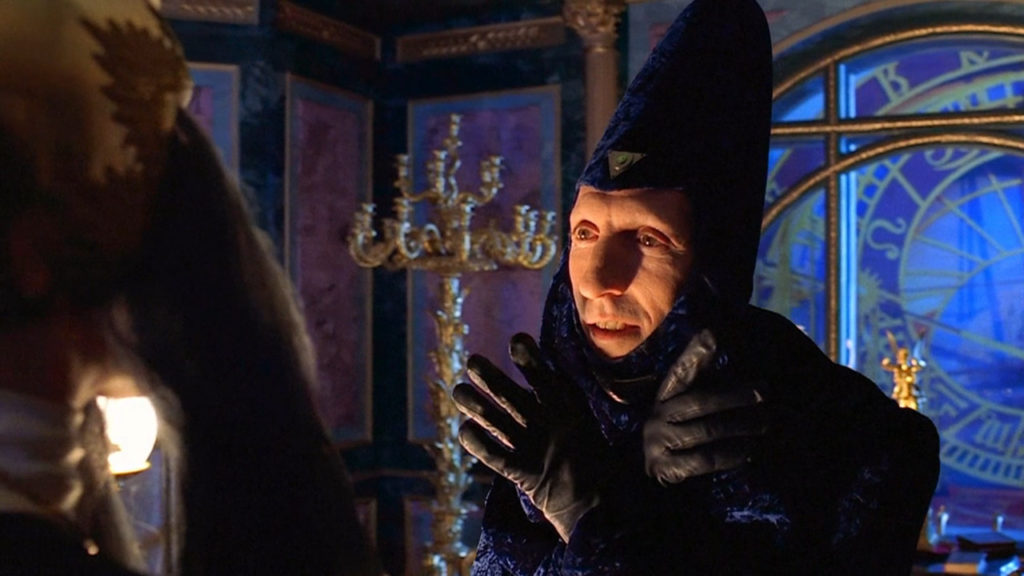
To bring the spice mutated Space Guild navigator to the screen, Harrrison and his team created a fleshy bat-like monstrosity that, thankfully, has minimal screen time. When it comes to the more human representatives of the Spacing Guild, however, it feels like the production designers might have gotten a hold of a copy of the pitch book Alejandro Jodorowsky’s used for his vision of Dune. Considering the involvement of French artist Moebius (Jean Giraud) in that production, the very Arzach-like design of the Spacing Guild Agent’s headgear has to be more than just a coincidence.
There Is a Problem on the Horizon…

Despite his relatively small amount of screentime, and relatively tall hat, as the main Spacing Guild Agent, Philip Lenkowsky provides one of the odder joys of the series. From his velvet costuming (and that hat) to his off-kilter delivery, and accompanying wild hand movements, he’s a hoot to watch in every scene he’s in. In one pivotal meeting with the Bene Gesserit and the Padishah Emperor Shaddam IV, he’s either sitting on a high stool hidden under his robes or just standing on one leg, for the entirety of the scene! Why? Because “the eye that looks ahead to the safe course is closed forever.”
The Villenueve Way
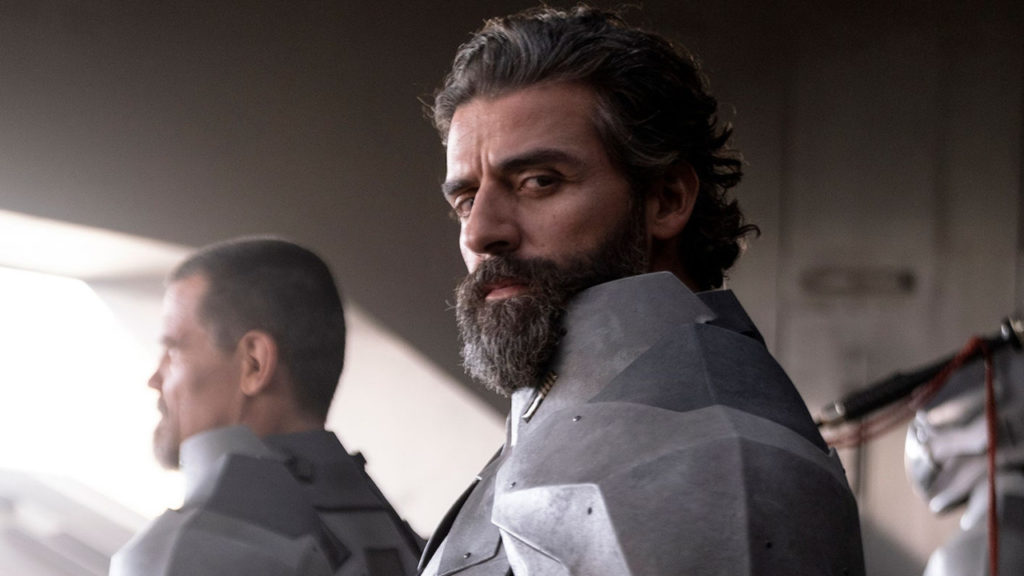
Despite some of the ill advised choices made, Frank Herbert’s Dune remains pretty enjoyable, both earnestly and ironically. At the time of release, the miniseries was a massive smash for the then Sci-Fi, now “SyFy”, Channel and it can still be quite riveting watching it today (if you ignore or squint at the CGI).
So what lessons can Denis Villeneuve hopefully learn from it for his version?
As mentioned above, one that John Harrison and the producers learned themselves with Children of Dune, was to give the material and the characters more room to breathe. Truly adapting the material in order to make the cast sound more like human beings as opposed to puppets spouting epic lines.
With the casting of Josh Brolin as Gurney Halleck and Jason Momoa as Duncan Idaho, hopefully Villenueve will also build up these characters’ relationships with Paul more. Despite some stiff acting from P.H. Moriarty as Gurney Halleck initially, you do feel some of the joy when Gurney resurfaces, after disappearing from the story. While Duncan Idaho may only return if, like Sci-Fi, Warner Bros decide to adapt the remaining books in the series, actually seeing the friendship between these characters on-screen, instead of just being told about it, would make it far more emotional.
Seeing as Villeneuve has already switched the character of Liet Kynes from male to female, it’s a good sign that he’s not against slaughtering a few sacred cows when it comes to adapting the material.
The Weirding Way

With the advances in the depiction of martial arts on-screen, from The Matrix to John Wick, to other action movies not starring Keanu Reeves, Villenueve should finally be able to bring the “weirding way” martial art of the Bene Gesserit to life. While Lynch avoided depicting it altogether, reinventing the Fremen’s tactical advantage as the sound based weirding modules, the miniseries only demonstrates it briefly, and shows it just as a blurring of the actor as they avoid some attack.
Hopefully Villenueve is brave enough a filmmaker to finally give the Dune Die-hards what they really want; ninja space nuns and LESS HATS!
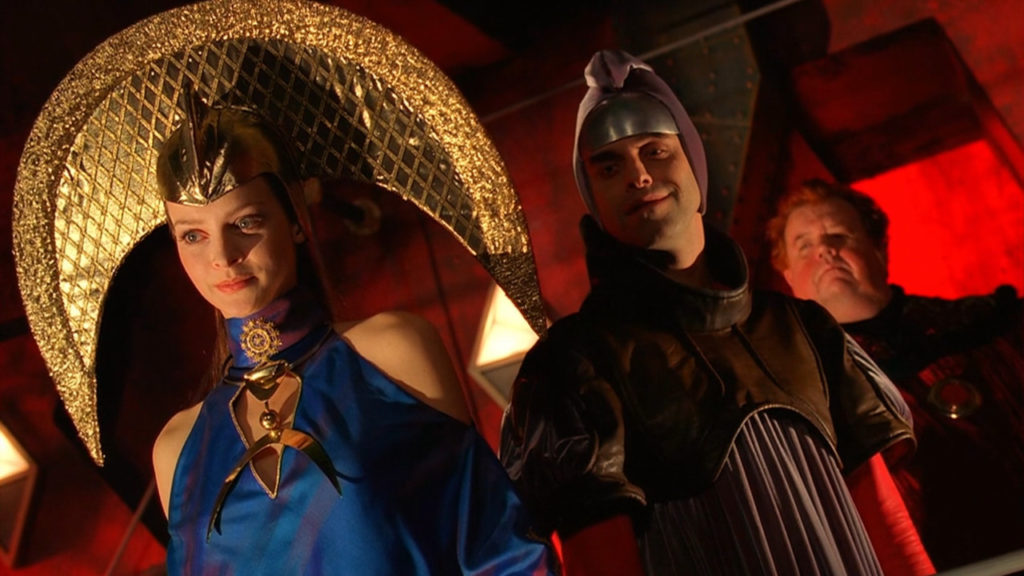
Frank Herbert’s Dune
Sci-Fi Channel , Season 1, 3 Episodes
Showrunner: John Harrison
Writers: John Harrison and Frank Herbert
Cast: Alec Newman, William Hurt, Saskia Reeves, P.H. Moriarty, Ian McNeice, Matt Keeslar, Giancarlo Giannini, Julie Cox, Uwe Ochsenknecht, Uwe Ochsenknecht, Laura Burton, James Watson, Barbora Kodetová, and Karel Dobrý
Children of Dune
Sci-Fi Channel , Season 1, 3 Episodes
Showrunner: Greg Yaitanes
Writers: John Harrison and Frank Herbert
Cast: Alec Newman,James McAvoy, Daniela Amavia P.H. Moriarty, Ian McNeice, Julie Cox, Barbora Kodetová, Karel Dobrý, and Susan Sarandon,




